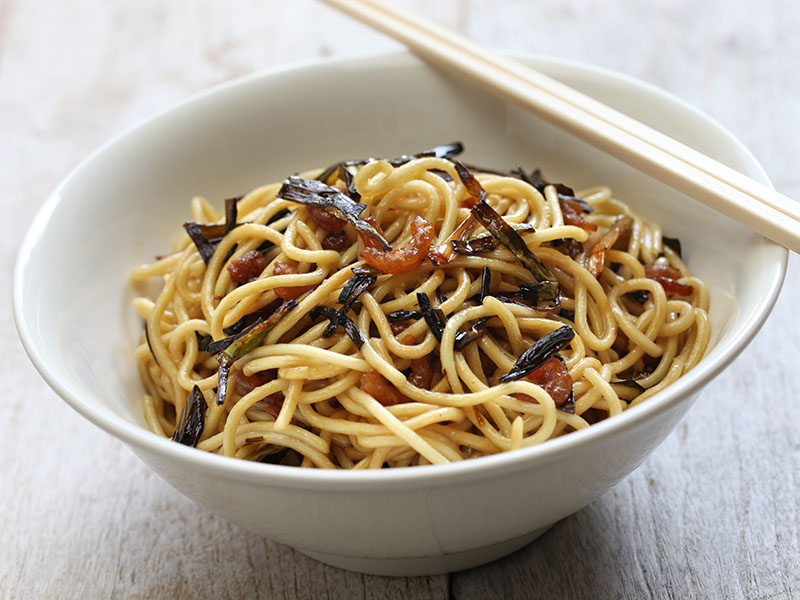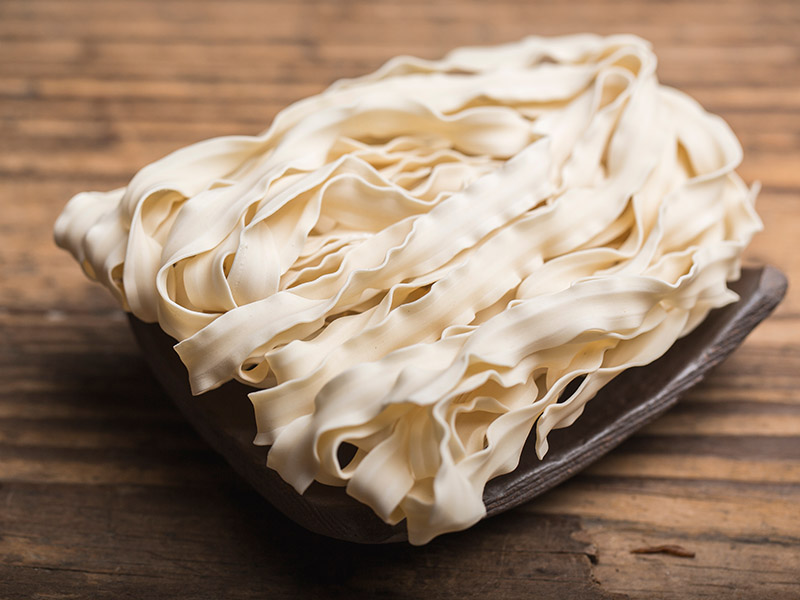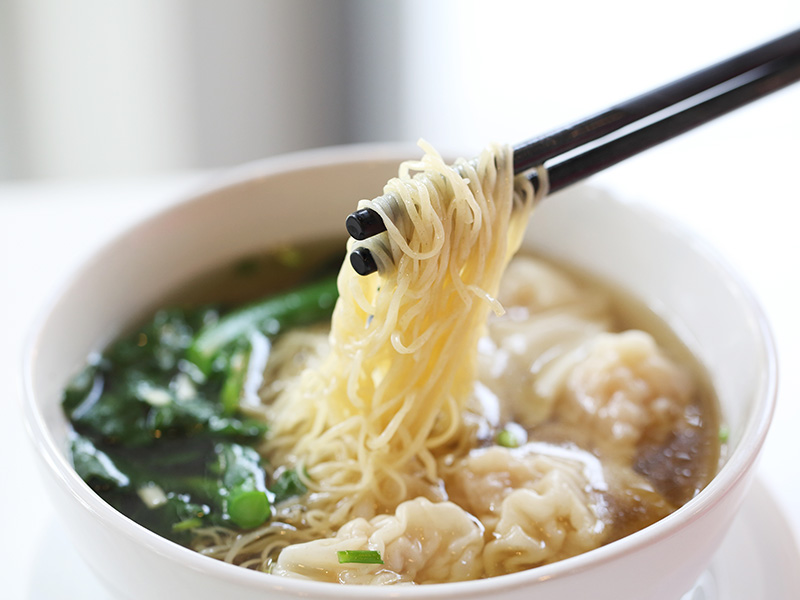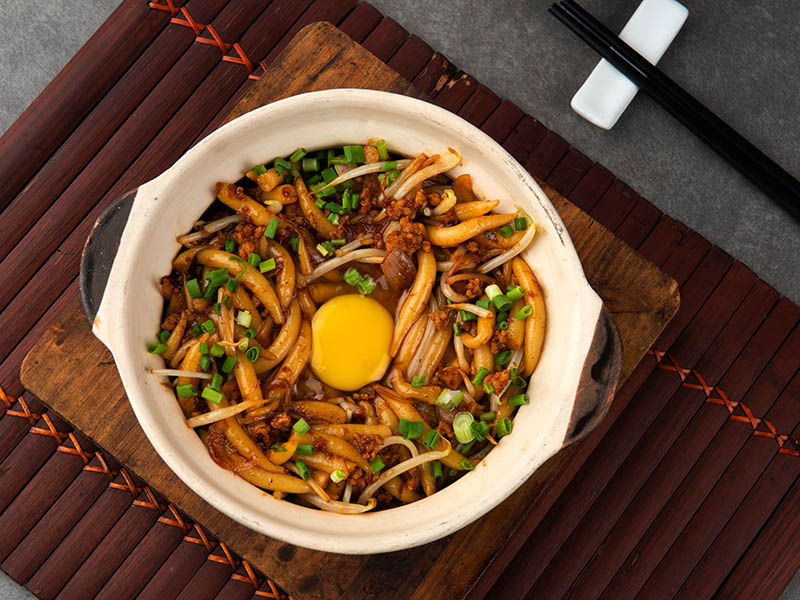There are different types of Chinese noodles for you to choose from when it comes to cooking based on the dish you want to create. The options are endless, from the creamy and spongy wheat-based noodles to the more gelatinous rice noodles.
This type of Chinese delicacy has been a part of the country for centuries, going as far back as the Han dynasty (3rd century B.C – 3rd century A.D). Due to the spread of Chinese culture, other countries have adopted this ingredient into their everyday meal.
It would be a daunting task for beginners to choose the right noodles since the variety might overwhelm them. That’s why I am here to help with this extensive list. After reading through this article, I can assure you will make the right choice for your dish.

The Delightful List Of Wheat Noodles From China
One of the most common types on the market is wheat-based noodles, which are chewy and delectable. The white version contains mainly wheat flour, while the yellow version also has egg yolks or a small amount of lye water.
1. Wheat Vermicelli (Misua)

Chinese Wheat Vermicelli, or Misua, is a type of noodle that originated from the Fujian region of China. You can also find Misua in Southeast Asian cuisines like Malaysia, Singapore, and Vietnam.
One of the most notable characteristics of Misua is its thinness. You won’t have any trouble chewing through each strand of noodles. To earn that texture, the producer must add a bit of salt to improve the delectability.
You can prepare this type of thin noodles in multiple ways, including adding them to noodle soups or stir-frying them with meat and vegetables.
This is the creation of the longest Misua in China.
2. Lo Mein Noodles

When you’re talking about Chinese noodles, the first thing that might pop into your mind is Lo Mein. This iconic delicacy comes with spectacular ingredients, including special noodles consisting of wheat flour and egg yolks.
Using the traditional Chinese cooking method of boiling noodles, the texture of Lo Mein will become a bit firmer. This adds a side of sponginess to the thickness of the noodles.
The best thing about Lo Mein is the texture. This type of noodles will not become soggy after drenching them in a truckload of sauce. The chewiness becomes even more incredible because the sauce adds more body to the noodles.
Lo Mein noodles are very creamy and rich, thanks to both flour and eggs in their base form. You can feel the taste at the tip of your tongue.
3. Teochew Flat Noodles (Mee Pok)

Mee Pok is a delicacy from the Teochew people, an ethnic minority originating from the southern region of China. Due to the heavy immigration of Teochew people, you can see this specialty pop up around Southeast Asia as well.
The characteristics of traditional Mee Pok noodles are pretty flat and stringy. The main ingredients of this type of noodles consist of wheat flour and water, but the yellow also comes from egg yolks.
The most common way restaurants and eateries prepare Mee Pok is to boil it in hot water before adding soup broth and meatballs.
4. Hand-Pulled Noodles (La Mian)

If you’re familiar with Asian food, you might have heard of the word “Ramen” in many Japanese restaurants. Let me introduce you to the originator of that delicacy: A Chinese noodle variant called La Mian. The first recorded recipe for the Chinese specialty made its debut in 1504.
Comparing Chinese La Mian and Japanese Ramen is important in knowing how different Chinese foods are from Japanese ones. The noodles from China feel slightly thinner than the version in Japan.
The primary method of making La Mian is forming the dough and pulling until the dough becomes thin strands of noodles. The cook will boil the noodles to fortify the starch, which will enhance the firmness. The process helps the La Mian noodles become chewy and spongy.
Aside from China, you can find these hand-pulled noodles in many supermarkets around the world. But in case you prefer authenticity, you can make the noodles yourself.
Lanzhou La Mian is a very popular variant in China.
5. Oil Noodles (You Mian)

You Mian is a particular noodle that doesn’t contain only wheat and eggs. The secret ingredient that makes this delicacy so good is corn oil.
Oil Noodles have been a part of Chinese cuisine for as early as the Ming dynasty (14th – 17th century A.D). Although corn oil is one of the main components, you won’t feel any greasiness upon tasting the noodles. The creaminess can mask everything.
The use of Oil Noodles has created some of the best Chinese dishes out there, including Scallion Oil Noodles and Sesame Oil Noodles.
6. Knife-Cut Noodles (Dao Xiao Mian)

When you have a chance to experience Shanxi province in China, you will come across many street food carts selling Dao Xiao Mian or Knife-Cut Noodles.
Instead of stretching the dough to get the perfect length, the cook usually folds the dough into multiple layers. The method will increase the size and the thickness of each noodle strand. That sort of texture is what most people love about Dao Xiao Mian.
You will see a chef perform this in front of a restaurant to attract many spectators and potential customers. First, they will form the dough and cut it into thin strands of noodles. That’s where the delicacy got the name “knife-cut”.
7. Long Life Noodles (Yi Mein)

In Cantonese tradition, Yi Mein is a must-have in every birthday celebration; most people refer to the delicacy as “Long Life Noodles”.
The core components for Yi Mein are still wheat flour and water. The yellow usually comes from egg yolks or rye water. However, Yi Mein usually requires one more step: Deep-frying until the overall texture gets nice and crunchy.
The crunchiness improves the taste by creating an oil coating, which might make the noodles slightly greasy. However, when you pair them with a type of sauce, the pleasant delectability will wash over your taste buds.
Yi Mein has a meaningful role in celebrating one’s birthday in Cantonese culture.
8. Wonton Noodles

Wonton Noodles was created during the Tang dynasty (7th – 10th century A.D). Aside from China, this delicacy is also an essential part of other Asian cuisines, including Indonesia, Malaysia, and Singapore, where most Chinese immigrants reside.
Wonton Noodles are similar to egg noodles because they contain flour, water, and egg yolks. However, the texture of this type of noodles is a bit chewier than your traditional egg noodles. The noodle strands are pretty thin and creamy.
When you pair Wonton Noodles with sauce or broth, the noodles will soak up the essence to enhance their flavor.
Chinese Rice Noodles Make So Many Great Meals
Rice noodles are another popular noodle variant that you can buy in many supermarkets. Unlike wheat-based noodles, the texture of rice noodles tends to be softer and more bouncy. This type is good at absorbing flavors from different sauces.
9. Rice Vermicelli (Mi Fen)

One of the most popular rice noodle variants in China, Taiwan, and Hong Kong is Rice Vermicelli or Mi Fen. This specialty has been a regular part of many famous Chinese delicacies for centuries. It is also the main ingredient in many popular dishes in Malaysia, Indonesia, and Vietnam.
The main ingredient in Mi Fen is rice flour combined with water to create a sticky dough. The rice-based version is a lot less chewy than wheat noodles, but you can still feel the slight bit of resistance in the texture.
In China, Rice Vermicelli is a popular component of many regional delicacies in Fujian, Guangdong, and Yunnan.
10. Thick Rice Noodles (Lai Fun)

When you want to experience a variety of rice noodles, Guangdong is first region you should visit. Aside from Ho Fun, Lai Fun is quite a delectable specialty, thanks to its texture and appearance.
The best way to get a perfect Lai Fun dough is still mixing water and rice flour. But instead of regular rice, you use sticky rice to increase the starchiness and the sponginess of the noodle texture.
Lai Fun is unique in its look since you would get thick strands of noodles instead of thin ones. The size means that a serving of Lai Fun would be more filling to your stomach, and the creaminess is much more apparent.
Thick rice noodles are really quick to make if you have the right ingredients.
11. Flat Rice Noodle (Ho Fun)

Ho Fun, or Shanhe Fen, is a staple of Cantonese cooking. The original birthplace of Ho Fun was in Guangzhou province of China. Ho Fun is also available in countries with many Chinese immigrants.
To produce a batch of Flat Rice Noodles, the maker must put the grains through a grinder to create flour. The next step is to mix water with the rice flour to get a soft dough. Finally, cut the dough into flat strands of noodles.
The texture of Ho Fun is very stretchy. People selling this type of noodles tend to drizzle oil on them to prevent the noodles from sticking to each other. Chow Fun, a popular Cantonese stir-fried dish, uses Ho Fun noodles as the base.
12. Silver Needle Noodles (Yin Zhen Fen)

Aside from the name “Silver Needle Noodles”, many people often refer to Yin Zhen Fen as “Rat Noodles” since they resemble a rat’s tail. Yin Zhen Fen enjoys massive popularity in China, Hong Kong, and many Southeast Asian countries despite having an unconventional name.
This type of noodles requires two components, including rice flour and water. However, in some cases, the makers can add cornstarch to the mixture to thicken up the consistency of the dough, creating a very spongy texture.
Yin Zhen Fen is often available fresh on the street, so you can easily buy those noodles for your meals. This delicacy is quite versatile in stir-fries or noodle soup dishes.
13. Yunnan Rice Noodles (Mi Xian)

Straight from the heart of Yunnan province, this type of noodle has captured the taste buds of many eaters. Despite the similarity to other rice-based noodles, Mi Xian still has ways to stand out.
The preparation for Mi Xian requires a period of fermentation. This process allows the yeast to work, creating a slightly doughy taste in the noodles. The noodles come in various sizes, both thick and thin.
Mi Xian is often a popular component in many Yunnan-originated noodle soups, and one of the best examples is Xiao Guo Mi Xian or “Crossing The Bridge”. The addition of broth increases the tenderness of the noodle strands.
Mi Xian is getting a lot of recognition around the world.
Other Types Of Chinese-Styled That You Can Check Out
Apart from the two main noodle types above, there are other options you might want to consider. Although the entry below belongs to a different category, you can still use it in many famous Chinese delicacies.
14. Glass Noodles (Fensi)

Glass Noodles or Cellophane Noodles are unlike anything you have ever tasted before. Unlike the above entries where you see noodles from wheat and rice flour, Glass Noodles use mung bean starch as the base.
Most starches have an exciting characteristic after you boil them in hot water. The starch will become transparent, so people call noodles made from a type of starch “Glass Noodles”. Apart from beans, some recipes utilize sweet potato starch.
The texture of Glass Noodles is somewhere between gelatinous and soft. You can easily chew through them with just one big bite, which will exude a faintly nutty flavor. The starchiness is excellent for when you want to thicken up a bowl of soup.
Glass noodles, or bean thread noodles, are quite suitable for many recipes.
Different Ways To Cook Chinese Noodle Recipes
Understanding noodles is one thing, putting that knowledge to good use is another. That’s why I’ve also prepared some of the most notable and fantastic noodle recipes to help you get used to this side of Chinese cuisine.
1. Stir-Fried Noodles (Chow Mein)
Total time: 25 minutes
Chow Mein is one of the more popular staples of Cantonese cuisine from China. You can find many restaurants and eateries selling this dish not just in mainland China but also in places where there are many Chinese immigrants.
In this recipe, the required ingredients are carrots, cabbage, and shiitake mushrooms. And, of course, the main player here is the creamy and chewy Chow Mein noodles.
The main preparation method is just stir-frying most of the ingredients together. While doing that, drizzle in a special glaze of soy sauce, vegetarian oyster sauce, and black vinegar to enhance the overall flavor with savoriness.
2. Stir-Fried Rice Noodles (Chow Fun)
Total time: 17 minutes
In this entry, I want to show you how to use the delectable flat rice noodles to create this fantastic Cantonese dish called Chow Fun.
In essence, Chow Fun is quite similar to Chow Mein regarding preparation. Aside from rice noodles, the other ingredients are shiitake mushroom and fried tofu. During the stir-frying, you can add an extra dash of oyster sauce, soy sauce, and Chinese cooking wine (Shaoxing).
When you cook Chow Fun, make sure to stir regularly so the combination of sauces will coat the food evenly. This will have the effect of improving both the texture and the taste. The noodles soak in all the flavors to create a great experience for you.
Chow Fun from Guangdong attracts many eaters due to its flavors and textures.
3. Yunnan Rice Noodle Soup (Xiao Guo Mi Xian)
Total time: 1 hour 15 minutes
Xiao Guo Mi Xian comes from the Yunnan province of China. The dish’s name means “Little Pot Noodle” in English, which refers to how the noodles are served in a small pot in Yunnan restaurants.
This recipe uses the Mi Xian noodles that I’ve talked about above. The texture of the noodles is quite spongy. Not just that, but there are also other components like ground pork, chicken stock, and bean sprouts.
The union of pork and stock will give the soup a savory taste. But the bean sprout reduces the richness to a more palatable level.
4. Wonton Noodle Soup
Total time: 1 hour 5 minutes
Whenever you feel your whole body slowing down, a bowl of Wonton Noodle Soup is all you need to brighten your day. The texture and flavor of the noodles are so memorable that you can’t stop eating after one bowl.
The ingredient list comes in two parts. The first part comprises the usual egg noodles, while the second consists of dumplings. To make dumplings, you fold the meat filling inside Wonton wrappers. If you don’t have time, you can buy frozen pre-made dumplings instead.
Since this is a soup, the use of chicken stock is necessary to improve the juiciness of the ingredients. The Wonton dumplings are very meaty and savory, but the noodles provide the creaminess to balance the taste.
Wonton Noodle Soup is a delicacy you share with the whole family.
Understanding Chinese Noodles Will Be Helpful
Noodles have been a regular part of Chinese cuisine for centuries, back to the Han dynasty. And yet, the delicacy has never lost its place in Chinese society when many new ingredients and dishes start popping up.
Since noodles have always been the basis of Chinese cuisine, they would be an excellent start for your culinary journey in China. Hopefully, my list above will be able to help you experience the beauty of Chinese cooking.
Finally, let me say thank you for following this article. If you want to recommend your favorite noodles, comment below. And make sure to like and share this post on various social media. Until you and I meet again, have a pleasant meal!



Truc Tran (Kris)
Expertise
Home Cooking, Meal Planning, Recipe Development, Baking and Pastry, Food Editor, Cooking-video Maker, Asian Food Content Creator, Vietnamese Food Evaluation Expert
Education
Program: Diploma of Hospitality (Commercial Cookery)
Focus: The culinary program included a Certificate III in Commercial Cookery, a Certificate IV in Kitchen Management, and a Diploma of Hospitality Management. This education provided a comprehensive blend of theoretical and practical training in finance, sustainability, diversity, and human resources management.
Program: Culinary Arts at Kendall College (Australia Branch in Sydney)
Focus: Explored global cuisines, and developed entrepreneurial abilities to manage a successful food business, along with acquiring essential language, math, computer, and communication skills for success.
Program: Certificate of Vietnamese Cuisine Head Chef
Focus: Master traditional and modern Vietnamese cooking techniques.
Truc Tran, or Kris, is an accomplished food editor with extensive training in hospitality and culinary arts, including a deep focus on Vietnamese cuisine from various prestigious institutions. She possesses over nine years of experience, developing her expertise in global cuisines and blending traditional Vietnamese cooking with contemporary trends to create engaging and educational content.
She also has a rich educational background, including a Diploma of Hospitality from TasTAFE and a Bachelor of Arts in Culinary Arts from Kendall College’s Sydney branch. It enables her to offer unique insights into meal planning, recipe development, and food culture, making her articles and cooking videos both informative and appealing.